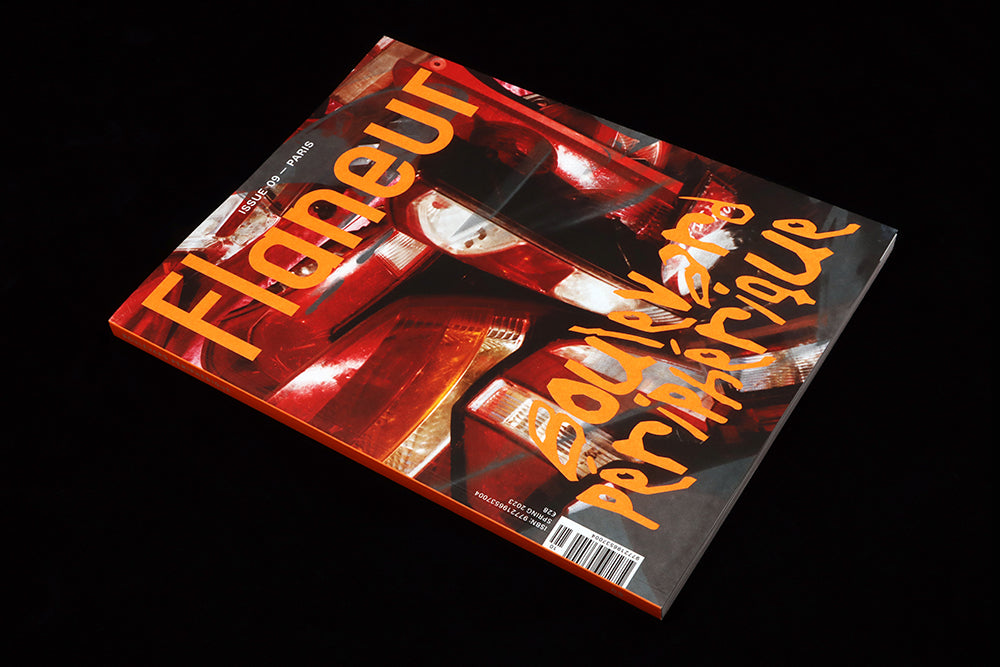
Flaneur #9—Paris
Four years after their neon-vivid Taipei issue, Flaneur overcomes Covid delays and returns with an issue devoted to Paris’s Boulevard Periphérique.
Each issue of Flaneur reflects the experience of a single road; the team usually spend a couple of months on site, getting to know the street, literally walking and talking to form the stories for the issue (hence the name Flaneur). The magazine reflects the people, culture and context of the chosen thoroughfare. The result in Taipei—where they set up base on the Kangding/ Wanda Road—was a joyous close-up celebration of a relatively little-known culture.
The new Paris issue offers a very different vibe. Once a futuristic dream of modernity and success, today the Boulevard Periphérique is generally dismissed as a notorious ring road splitting the beautiful, low-rise tourist Paris from its suburbs. Such noteriety provides great meat for the Flaneur team of course, but also a far less cosy ride than the Taipei trip.
Used to spending two solid months on site, the team had to work differently for this issue, as co-editor Grashina Gabelmann explained to me, ‘We worked on the issue from 2019 until its launch April 2023, and travelled back and forth with a big pandemic-related break during which we were in touch and workshopping via zoom with our four curating editors.’
Here’s a quick check over the issue in five spreads.

One
The issue opens and closes with ‘Finir au McDo’, a series of collaborations between artist Antoine Leisure and photographer Matthieu Gafsou. There are eight spreads at each end of the issue, linking the issue into one never-ending ring, like the Perphérique itself. Gafsou’s harsh architectural images depict the hidden spaces between, beneath and around the steel and concrete of the ring road. They are softened by Leisure’s art, as art director Michelle Phillips explains, ‘There’s a huge comic illustration scene in Paris, and although the art is not a direct reference to graffiti, Leisure’s works bleed over the edge of his given space and scrawl over Gafsou’s pristine photos to similar effect.’

Two
As well as building the Periphérique in the sixties, the Paris government attempted to address the city’s housing crisis by building modernist apartments around the ring road. One vast example was a development on an area called Cité, the story of which unfolds in a chaoticly designed text (French and English language versions adding to the chaos) that draws together the idealism of Le Corbusier, his plans for Algiers, Haussmann’s historical replanning of Paris, and the imminent destruction of the tower blocks of Cité. This is Flaneur at its best, switching between the macro and micro to cover the poilitics and idealism of modernism alongside contemporary local voices. What transpires is that today’s migrant occupants of the area are being treated with the same disdain as their predecessors were in the sixties, ironically in the name of righting a wrong. (Note the ring road diagram around the edge of the spread).

Three
Later in the issue we come face to face with some of the people living in Cité. Portraits accompany interiews as each person reflects on their life in the area, the lack of coherent planning for their future as the government force through demolitions, and their fears for their futures. Open and frank, the voices cut through the politics and history of the area.

Four
Alongside the sociological and political stories, a more typical Flaneur art project is photographer Alassan Diawara’s portfolio ‘35.04’, the length of the ring road in kilometres. Alassan walked for two weeks, allowing himself one roll of film per day, shooting people, cars, debris etc. These pages are presented very simply, in a gallery style unlike the hyped design of the rest of the issue.

Five
The final story in the issue shows how the longstanding French appreciation of the comic strip can adapt to new contexts. Created by two young women, Plume Banlieue posts stories on Instagram and Twitter, telling the stories of the suburbs and highlighting the diversity of voices. Their full-pages stories in the magazine emphasise simple human stories that end the issue on a positive note.
We’re used to magazines that approach their subject with clever thematic devices and various parameters, but nobody else is doing quite what Flaneur does. Every issue is a coherent whole, properly researched, developed and produced, but also unique, responding to the street in question. It’s great to have it back.
Publisher Ricarda Messner
Editors-in-chief Fabian Saul and Grashina Gabelmann
Art direction and design Studio Yukiko


